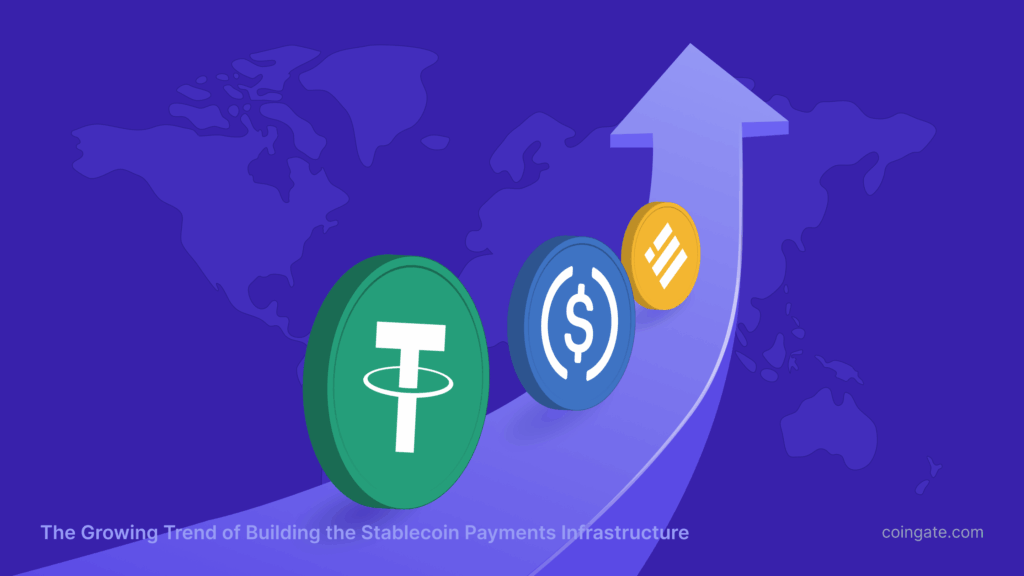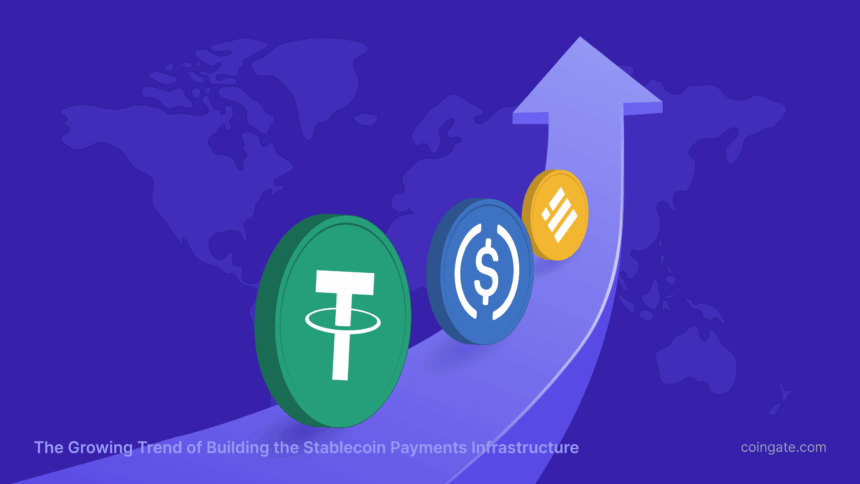This article offers an analysis of how to build an enterprise level stablecoin by outlining the necessary steps, innovation, technologies, and compliance requirements to develop a digital asset that operates securely and flexibly in the digital economy.
I will focus on how a business can set up reserve models, build smart contracts, ensure compliance, and deploy a stablecoin that facilitates seamless and transparent operations, resulting in a significant reduction in operational costs.
What is Stablecoin Models?
The many methods used to maintain a stablecoin’s value tied to an item, such as fiat money, commodities, or other cryptocurrencies, are referred to as stablecoin models. Algorithmic stablecoins, crypto-collateralized stablecoins, and fiat-backed stablecoins are the three main concepts.

Fiat-backed stablecoins are the most reliable and trustworthy for businesses since they have reserves of actual currency. Digital assets are used as collateral in crypto-collateralized stablecoins, which provide decentralization but are more volatile.
Although they are riskier, algorithmic stablecoins use smart contracts to modify supply and demand. Organizations can select the most scalable, secure, and compliant framework for creating an enterprise-grade stablecoin by having a thorough understanding of various models.
How to Build an Enterprise Stablecoin

Example: How to Build an Enterprise Stablecoin (Step-by-Step)
Step 1: Define Purpose
A global logistics firm needs a USD-pegged stablecoin called LogiUSD to help facilitate cross-border payments, reduce delays from bank and automate settlements with partner.

Step 2: Select a Blockchain Ecosystem
The firm selects Ethereum (Layer 2 like Base or Polygon) because of low fees, fast transaction and great developer support.

Step 3: Determining the Reserve Model
LogiUSD will be 100% fiat-backed. For every token in circulation there are 1 USD in storage at a regulated custodian bank. Auditors do monthly snapshots.
Step 4: Create Smart Contracts
Create ERC20 smart contract that allows:
- Token minting when USD gets deposited
- Token burning when redeemed
- Transaction limits and automation
- Pause and blacklist functions for regulatory compliance
Third parties will audit the contract for security.
Step 5: Establish Treasury Management and Custody
The firm will engage with a licensed custody partner to safely store USD reserves.
The treasury dashboard enables the group to track deposits and reserves, understand their obligations, and observe the instantaneous supply of tokens.
Step 6: Building the Technical Architecture
- Integrating API with ERP and payment systems.
- Staff and partners get a stablecoin wallet.
- There’s a compliance engine for KYC/AML.
- A dashboard for reports is in the works.
Step 7: Setting Up Compliance and Legal
LogiUSD is compliant with the following on the Legal Team’s end:
- Regulations on money transmission in the jurisdiction.
- KYC/AML verification.
- Regulations related to stablecoins (e.g., reporting on reserves, licensing).
LogiUSD’s Compliance Team and Legal Counselys’ prepare communication for regulatory authorities and relevant partners.
Step 8: Implementation of Security
Hardening security involves:
- Multi-signature wallets.
- Monitoring tools for on-chain activities.
- Fraud and threat prevention.
- Penetration testing of smart contracts.
Step 9: Testing & Simulations Internally
The company carries out:
- Operational testing.
- Testing to determine systems stress capacity.
- Partner specific testing.
- Simulations for the partner in the role of user.
Employees in a separate instance of the application used LogiUSD in a sandbox.
Step 10: Launching the Enterprise Stablecoin
The company Logi has USD Just now:
- Payments to suppliers.
- Settlements with partners.
- Transfers to treasury are now internal.
The second phase is to get external partners on board worldwide.
Best Practices for Long-Term Success
Maintain Transparent Reserve
Trust is secured by systematically communicating the results of audits and proof of reserves and by providing external, live evidentiary dashboards.
Stay Updated with Regulations
Global stablecoin regulation is continuously surveilled and compliance obligations are updated and or enhanced.
Implement Strong Security Controls
Hacks are mitigated through the use of multisig, cold wallet storages, and smart contract breaches are continuously monitored.
Ensure High Scalability
Operation on scalable blockchains is of utmost importance, along with the continuous, dynamic adaptation of the infrastructure to growing transaction volumes.
Regularly Audit Smart Contracts
By engaging third-parties to review and test code annually, gaps in high and critical vulnerabilities exploitation are informed.
Enhance User & Partner Education
Users of the stablecoin system are supported with amplified documentation and training.
Maintain Liquidity & Reserve Efficiency
Proper management of reserves is required to instantaneously redeem and maintain stable pegging.
Develop a Robust Incident Response Plan
Cybersecurity events are anticipated and pre-defined response actions and/or escalations are put in place.
Adopt Continuous Improvement Practices
Feedback is collated, and feature, API, and integration performance are analyzed to shift in a reconfigured, enhanced system.
Key Components of an Enterprise Stablecoin
Blockchain Infrastructure
This is a base of the network (Ethereum, Hyperledger, private chains) and the factors surrounding it which include, scalability, speed, and security
Smart Contract Architecture
This includes the code that explains the details on minting, burning, transfers and automation functions, along with compliance rules.
Reserve & Custody Mechanism
This is the financial structure that makes sure every stablecoin is backed by their respective stable assets, which can be fiat, crypto, or other financial instruments and it is stored with a regulated custodian.
Compliance & Regulatory Framework
This includes KYC/AML processes, permissioning, and auditing processes to satisfy financial regulations at the global and regional levels.
Token Model & Peg Mechanism
This is the stablecoin design that helps it to achieve and sustain a fixed value (fiat-backed, crypto-backed, or algorithmic).
Security Architecture
This includes the multi-sigs, encryption, monitoring, and stress testing of the system that safeguards the funds and the smart contracts.
Wallet & User Access System
This entails wallet systems (mobile, web, API) for businesses, staff, collaborators, and customers.
API & Integration Layer
This allows the stablecoin to bridge with other enterprise systems like ERP, accounting systems, payment systems, and banking interfaces.
Transaction Monitoring Tools
Advanced Engine for Real Time Risk Processing for fraud detection and for tracking compliance, potentially suspicious activity reporting.
Challenges and Risks
Regulatory Uncertainty
Engagement and compliance can be impacted (whether positively or negatively) by the operational costs, and by regulatory shifts and the legal frameworks of stablecoin’s geographies.
Security Vulnerabilities
There are risks of financial and reputational loss due to breaches, exploits and cyberattacks resulting from weak security within the ecosystems of smart wallets, and the system’s overall weak ecosystem.
Liquidity & Reserve Management
The requirement to manage reserves within the ecosystem can pose risks to the ecosystem, with challenges of providing rapid liquidity and preventing liquidity gaps that result in losing control of the ecosystem.
Scalability Issues
There are challenges that weak ecosystems may face, including losing control of cost variables, and the ability to scale to meet the demands of an ecosystem by optimizing high-volume, low-resource transactions.
Interoperability Limitations
Weak ecosystems may face challenges including losing control of cost variables, and the ability to scale to meet the demands of an ecosystem by optimizing high-volume, low-resource transactions and weak cross-chaning capabilities.
Market Trust & Transparency
Weak ecosystems may cease to lose control of both variable and system governance, with the operational system structures of prediction markets and volatility control preventing loss of overall operational control.
Operational Complexity
These weak ecosystems can result in losing substantially vertical governance control, with the central operator. Weak systems foundations are likely to reduce the aggregation of complex variables within governance systems
Technical Failures
An operational system can be vulnerable to weak control of variable systems resulting in a high level of operational dependence.
Reputation & Legal Risks
Weak systems and vulnerable control frameworks can result in a cascade of vulnerable control frameworks, with loss of control slowing down operational governance and increasing the level of operational dependence.
Pros & Cons
| Pros | Cons |
|---|---|
| Fast Cross-Border Payments – Transactions settle in seconds instead of days. | Regulatory Uncertainty – Changing global laws may affect operations. |
| Lower Transaction Costs – Reduces banking and remittance fees. | Security Risks – Smart contract bugs or cyberattacks can cause losses. |
| Improved Transparency – On-chain records provide real-time visibility. | Operational Complexity – Requires ongoing management, audits, and compliance. |
| Scalable Treasury Operations – Automates settlements and internal transfers. | Liquidity & Reserve Challenges – Must maintain adequate reserves at all times. |
| Global Accessibility – Easily integrates with partners and ecosystems worldwide. | Integration Issues – May require significant technical upgrades to legacy systems. |
| High Control & Customization – Enterprises design their own features, rules, and workflows. | Market Trust Concerns – Must constantly prove stability and reserve backing. |
Conclusion
Creating an enterprise stablecoin is a calculated step that enables companies to streamline international operations, increase transparency, and modernize payments.
Organizations can develop a stable, scalable digital asset that supports long-term growth by selecting the appropriate blockchain, creating a secure reserve model, putting robust compliance procedures in place, and upholding top-tier security.
Despite obstacles like integration and regulation, a well-thought-out strategy guarantees a stablecoin system that is dependable and trustworthy. Businesses can confidently enter the future of digital finance and uncover potent new efficiencies with the correct technology and governance.
FAQs
What is an enterprise stablecoin?
An enterprise stablecoin is a digital currency created by a business to enable faster, cheaper, and more controlled financial operations. It is usually backed by fiat or other assets to maintain a stable value.
How long does it take to build an enterprise stablecoin?
Development typically takes 3–12 months, depending on complexity, compliance requirements, blockchain selection, and integration needs.
Do companies need regulatory approval to launch a stablecoin?
Yes. Most regions require KYC/AML compliance, licensing for money transmission, and regular reserve audits. Regulations vary by jurisdiction.
Which blockchain is best for building a stablecoin?
Popular choices include Ethereum, Hyperledger Fabric, Solana, or private blockchains. The best option depends on scalability, security, and enterprise needs.
How much does it cost to build a stablecoin?
Costs range from $100,000 to $1 million+, depending on smart contract development, custody setup, audits, and regulatory requirements.







